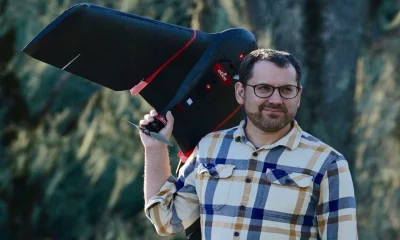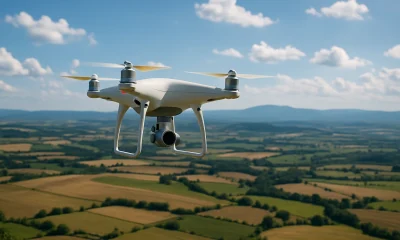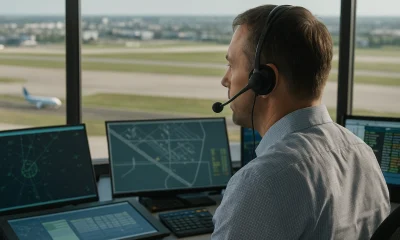U.S. Drone Regulations
Local Regulations for Drones in the U.S.
Published
1 year agoon
Table Of Contents

Local Regulations
Overview
In addition to federal and state regulations, local governments (cities, counties, and municipalities) can impose their own rules and restrictions on drone operations. These local regulations can vary widely and may address specific community concerns, such as noise, privacy, and public safety. It is crucial for drone operators to be aware of and comply with these local laws to avoid penalties and ensure respectful operations within different communities.
Importance of Checking Local Ordinances
Local regulations can significantly impact where and how drones can be flown. These laws may include:
- Designated no-fly zones, such as near schools, hospitals, or government buildings.
- Restrictions on drone flights in public parks and recreational areas.
- Curfews or time-of-day restrictions for drone operations.
- Noise limitations to reduce disturbances in residential areas.
Operators should always check local ordinances before flying to ensure compliance. Ignorance of local laws is not a valid defense in the case of violations.
Examples of City-Specific Regulations
New York City:
- General Ban on Drone Operations: NYC effectively bans the use of drones within city limits without special authorization from the Port Authority of New York and New Jersey. The dense population and complex airspace make it challenging to safely integrate drones into the urban environment.
- Restricted Areas: Specific locations such as Central Park, Times Square, and other high-traffic areas have explicit restrictions.
Los Angeles:
- Los Angeles Municipal Code Section 63.44(B)(8): Prohibits the use of drones in city parks without a permit. This regulation aims to protect the safety and privacy of park visitors.
- Airports: Strict regulations apply to areas around Los Angeles International Airport (LAX) and other local airports to prevent airspace conflicts.
San Francisco:
- Golden Gate National Recreation Area: Drone operations are prohibited within this national park to protect wildlife and ensure the safety of park visitors.
- San Francisco Police Code Section 7.03: Imposes restrictions on drone use in public spaces and requires operators to maintain a line of sight and avoid flying over people.
Chicago:
- Chicago Drone Ordinance: Prohibits the use of drones within certain areas, including downtown Chicago, without special permission. The ordinance focuses on preventing disturbances and ensuring public safety.
- Parks and Public Spaces: Requires permits for drone operations in public parks and spaces managed by the Chicago Park District.
Boston:
- Boston Drone Ordinance: Requires drone operators to obtain a permit from the Boston Parks and Recreation Department for flights in public parks. The regulation aims to balance recreational drone use with public safety and privacy concerns.
Resources for Finding Local Drone Laws
To stay informed about local regulations, drone operators can use the following resources:
- City Government Websites: Most cities provide information on local drone laws on their official websites.
- Local Law Enforcement Agencies: Contacting local police departments can help clarify specific regulations and enforcement practices.
- Community-Based Organizations: Groups such as the Academy of Model Aeronautics (AMA) can provide guidance on local flying sites and regulations.
Examples of Local Regulations and Their Impacts
Noise and Nuisance Laws:
- Some cities have implemented noise regulations to minimize the impact of drones on residential areas. Operators must ensure their drones comply with local noise standards to avoid fines and complaints.
Privacy Protections:
- Local ordinances may include provisions to protect the privacy of residents. For example, it may be illegal to fly drones over private property without the owner’s consent or to use drones for surveillance purposes.
Public Safety and Event Restrictions:
- During large public events, such as parades or sports games, local authorities may impose temporary no-fly zones to ensure public safety. Operators must check for any event-specific restrictions before flying.
Staying Updated on Local Laws
Local drone regulations can change frequently, so it is important for operators to stay informed about the latest laws. Regularly checking city websites, subscribing to local government newsletters, and joining drone operator communities can help ensure compliance with current regulations.
Frequently Asked Questions About Local Regulations for Drones in the U.S.
1. How can I find out if there are local regulations governing drone flights in my area?
Local regulations can vary widely from one municipality to another. To find out if there are specific rules in your area, check your city or county government’s official website. You can also contact local law enforcement or municipal offices directly. Additionally, the FAA’s B4UFLY app and community-based organizations like the Academy of Model Aeronautics (AMA) can provide information on local restrictions.
2. Are there common restrictions on flying drones in public parks or urban areas?
Yes, many cities and municipalities have specific rules regarding drone flights in public parks and urban areas. Common restrictions include prohibitions on flying over crowds, near schools, hospitals, and government buildings, or within designated no-fly zones. Some cities, like New York City and Los Angeles, require special permits for drone operations in public parks or densely populated areas. Always check local ordinances before flying.
3. What should I do if my drone flight plan conflicts with local regulations?
If your planned drone operation conflicts with local regulations, you should:
- Adjust your flight plan to comply with the local laws.
- Obtain any necessary permits or authorizations from local authorities.
- Consider alternative locations that do not have the same restrictions.
- Ensure that you have checked all relevant local, state, and federal regulations to avoid penalties and ensure safe operations.
These FAQs address key concerns about navigating local drone regulations in the U.S. For more detailed information, visit your local government’s website or contact local authorities directly.
To Learn more about acronyms used in this article visit our Drones Acronym Page.
Pros
Cons
You may like


Gregory Crutsinger, Founder of Scholar Farms – Innovator Series


What is RED (Rapid Extraction Device) & How Does it Work?


What is IED (Improvised Explosive Device) & How Does it Work?


What is BLOS (Beyond Line of Sight) & How Does it Work?


What is ATO (Authority to Operate) & How Does it Work?


What is ALPA (Air Line Pilots Association) & How Does it Work?